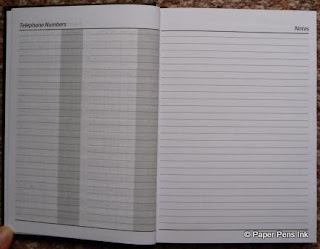Pros
I am still loving the size. Not only is the page aspect
ratio ‘right’ (following as it does the standard page size of A6), but being A6
(i.e. a quarter of A4) it is ridiculously easy to make inserts cheaply and to
exactly the format you want! If you haven’t yet checked out the range of
inserts on Philofaxy, go do soThe Cover
It was ‘pre-loved’ and although described as only used once, that once must have been tough! It came a bit dinged and battered, but, to be honest, I liked that. I still like it. I think it has a bit of an Indiana Jones look about it and I’m not afraid to throw the filofax in my bag (unlike the way I am a little more precious about my Baroque personal filofaxes).
The Quality
There has been a lot of coverage recently about the poor quality of filofax inserts, filofax binders, and the company in general. I am not about to start into all that, but I have been disappointed with Filofax both as a company and as a product recently. This Mulberry is (like old filofaxes) of good quality. The ring mechanism is perfect, the leather is great, the linings are robust etc.
Cons
Yes, there are some!The Pockets
On the inside cover (reverse of the front cover) there are two pockets: one partial-height pocket which has three card-slots in it and one full-height pocket behind. I have credit/bank cards in the card slots, which works fine. I keep paper-money in the full-height pocket. This is a little stiff and the opening of the pocket is a bit too close to the rings, making getting money out a little tricky. Thankfully, the cover is flexible enough to be able to bend it back to get easier access, but it could have been cut to the same size as the partial pocket’s width. The partial pocket is less useful to me. I have slipped receipts into it, but it’s not currently used much.
At the back, there is a zipped pocket with a full-height pocket behind. Currently I keep coins in the zipped pocket and cards I don’t need quick access to (but want to have on me) in a pocket-filofax card-holder, slipped into the full-height pocket. I have another of these pocket-filofax card-holders on the rings. The coin-pocket is a little tricky to get money out of and I’m contemplating re-using one of the coin-hacks I have used before, and moving stamps and other bits and pieces into the zipped pocket. I do like to be able to see how much money I have in change without having to root around in the pocket!
The Pen Loop
This is down as a con for me but would probably for many of you be a pro! It’s too big for me to put my Zebra biro/pencil combo in – it falls straight out. Currently, my pen/pencil combo is in a Leuchtturrm self-adhesive pen loop which is attached to a piece of acetate at the back (acting as pen-loop and paper protector combined).
Although it looks as if the cons are significant, they are all bearable, and the pros most definitely out-weigh them. To be honest, the ability to make my own inserts so easily is one of the biggest bonuses. It’s allowing me to contemplate making a whole host of custom-made inserts and print them on fountain-pen friendly paper. Bliss.
























